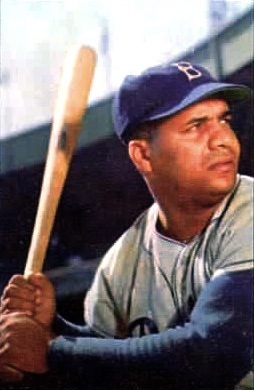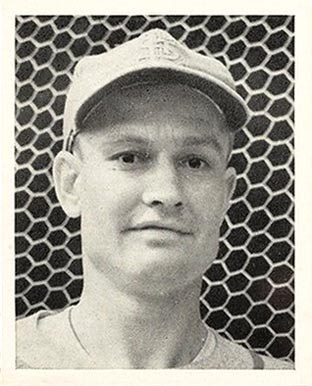|
Wes Westrum
Wesley Noreen Westrum (November 28, 1922 – May 28, 2002) was an American professional baseball player, coach, manager, and scout. He played for 11 seasons as a catcher in Major League Baseball for the New York Giants from to and was known as a superb defensive catcher. He served as the second manager in the history of the New York Mets, replacing Casey Stengel in 1965 after the latter fractured his hip and was forced to retire. Major League playing career A native of Clearbrook, Minnesota, Westrum was a stalwart defensive player for the New York Giants (1947–57) and, in his prime, a powerful right-handed hitter, although he had trouble making contact and hit for a low .217 career batting average. He began his major league career as the Giants' reserve catcher, playing behind Walker Cooper. When Cooper was traded in 1949, Westrum shared the catching duties with Ray Mueller for the remainder of the season. He became the full-time catcher for the Giants in 1950, leading Nat ... [...More Info...] [...Related Items...] OR: [Wikipedia] [Google] [Baidu] [Amazon] |
Catcher
Catcher is a position in baseball and softball. When a batter takes their turn to hit, the catcher crouches behind home plate, in front of the (home) umpire, and receives the ball from the pitcher. In addition to this primary duty, the catcher is also called upon to master many other skills in order to field the position well. The role of the catcher is similar to that of the wicket-keeper in cricket. Positioned behind home plate and facing toward the outfield, the catcher can see the whole field, and is therefore in the best position to direct and lead the other players in a defensive play. The catcher typically calls for pitches using PitchCom, or hand signals. The calls are based on the pitcher's mechanics and strengths, as well as the batter's tendencies and weaknesses. Essentially, the catcher controls what happens during the game when the ball is not "in play". Foul tips, bouncing balls in the dirt, and contact with runners during plays at the plate are all events ... [...More Info...] [...Related Items...] OR: [Wikipedia] [Google] [Baidu] [Amazon] |
Roy Campanella
Roy Campanella (November 19, 1921 – June 26, 1993), nicknamed "Campy", was an American professional baseball player, primarily as a catcher. The Philadelphia native played in the Negro leagues and Mexican League for nine years before entering the minor leagues in 1946. He made his Major League Baseball (MLB) debut in 1948 for the Brooklyn Dodgers, for whom he played until 1957. His playing career ended when he was paralyzed in an automobile crash in January of 1958. He is considered one of the greatest catchers in the history of the game. After he retired as a player as a result of the accident, Campanella held positions in scouting and community relations with the Dodgers. He was inducted into the Baseball Hall of Fame in 1969. Early life and education Roy Campanella was born in Philadelphia on November 19, 1921 to parents Ida, who was African American, and John Campanella, the son of Italian immigrants. Roy was the youngest of the four children born to the couple. They fir ... [...More Info...] [...Related Items...] OR: [Wikipedia] [Google] [Baidu] [Amazon] |
Assist (baseball)
In baseball, an assist (denoted by A) is a defensive statistic, baseball being one of the few sports in which the defensive team controls the ball. An assist is credited to every defensive player who fields or touches the ball (after it has been hit by the batter) prior to the recording of a putout, even if the contact was unintentional. For example, if a ball strikes a player's leg and bounces off him to another fielder, who tags the baserunner, the first player is credited with an assist. A fielder can receive a maximum of one assist per out recorded. An assist is also credited if a putout would have occurred, had another fielder not committed an error. For example, a shortstop might field a ground ball cleanly, but the first baseman might drop his throw. In this case, an error would be charged to the first baseman, and the shortstop would be credited with an assist. If a pitcher records a strikeout where the third strike is caught by the catcher, the pitcher is not credite ... [...More Info...] [...Related Items...] OR: [Wikipedia] [Google] [Baidu] [Amazon] |
Caught Stealing
In baseball, a runner is charged, and the fielders involved are credited, with a time caught stealing when the runner attempts to advance or lead off from one base to another without the ball being batted and then is tagged out by a fielder while making the attempt. The runner is said to be caught stealing or thrown out. A time caught stealing cannot be charged to a batter-runner, a runner who is still advancing as the direct result of reaching base. In baseball statistics, caught stealing is denoted by CS. It may be the result of a rundown. Major League Baseball (MLB) began tracking caught stealing in 1951. The official MLB rules specify that a time caught stealing is charged when: * a runner, attempting a stolen base, is put out; * a runner is caught in a rundown play while stealing, and is tagged out; or * a runner, attempting a stolen base, is safe because a fielder is charged with an error on catching the ball, and in the judgment of the official scorer, the runner would ... [...More Info...] [...Related Items...] OR: [Wikipedia] [Google] [Baidu] [Amazon] |
Fielding Percentage
In baseball statistics, fielding percentage, also known as fielding average, is a measure that reflects the percentage of times a baseball positions, defensive player properly handles a batted or thrown ball. It is calculated by the sum of putouts and assist (baseball), assists, divided by the number of total chances (putouts + assists + error (baseball), errors). While a high fielding percentage is regarded as a sign of defensive skill, it is also possible for a player of lesser defensive skill to have a high fielding percentage, as it does not reflect or take into account a player's defensive range factor, range; a player who cannot get to a ball surrenders a hit (baseball), hit instead of having an opportunity to make an out (baseball), out or an error (baseball), error. Conversely, a highly skilled fielder might have a comparatively low fielding percentage by virtue of reaching, and potentially missing, a greater number of balls. In order to qualify for the league lead in fie ... [...More Info...] [...Related Items...] OR: [Wikipedia] [Google] [Baidu] [Amazon] |
National League (baseball)
The National League of Professional Baseball Clubs, known simply as the National League (NL), is the older of two leagues constituting Major League Baseball (MLB) in the United States and Canada, and the world's oldest extant professional team sports league. Founded on February 2, 1876, to replace the National Association of Professional Base Ball Players (NAPBBP) of 1871–1875 (often called simply the "National Association"), the NL is sometimes called the Senior Circuit, in contrast to MLB's other league, the American League, which was founded 25 years later and is called the "Junior Circuit". Both leagues currently have 15 teams. The National League survived competition from various other professional baseball leagues during the late 19th century. Most did not last for more than a few seasons, with a handful of teams joining the NL once their leagues folded. The American League declared itself a second major league in 1901, and the AL and NL engaged in a "baseball war" durin ... [...More Info...] [...Related Items...] OR: [Wikipedia] [Google] [Baidu] [Amazon] |
1950 New York Giants (MLB) Season
The 1950 New York Giants season was the franchise's 68th season. The team finished in third place in the National League with an 86–68 record, 5 games behind the Philadelphia Phillies. Offseason * December 14, 1949: Sid Gordon, Buddy Kerr, Willard Marshall, and Red Webb were traded by the Giants to the Boston Braves for Eddie Stanky and Alvin Dark. * Prior to 1950 season: Al Sima was purchased from the Giants by the Washington Senators. Regular season Season standings Record vs. opponents Opening Day lineup Notable transactions * June 20, 1950: Willie Mays Willie Howard Mays Jr. (May 6, 1931 – June 18, 2024), nicknamed "the Say Hey Kid", was an American professional baseball center fielder who played 23 seasons in Major League Baseball (MLB). Widely regarded as one of the greatest players of ... was signed as an amateur free agent by the Giants. Roster Player stats Batting Starters by position ''Note: Pos = Position; G = Games p ... [...More Info...] [...Related Items...] OR: [Wikipedia] [Google] [Baidu] [Amazon] |
Ray Mueller
Ray Coleman Mueller (March 8, 1912 – June 29, 1994) was an American professional baseball player. He played as a catcher in Major League Baseball from 1935 to 1944 and 1946 to 1951. Nicknamed "Iron Man", Mueller was the starting catcher in every game the Cincinnati Reds played — 155 — during the wartime season.Information at Mueller caught a -record 233 consecutive games in 1943–1944 and 1946. Baseball career The native of |
1949 New York Giants (MLB) Season
The 1949 New York Giants season was the franchise's 67th season. The team finished in fifth place in the National League with a 73–81 record, 24 games behind the Brooklyn Dodgers. The games were now broadcast on the then new station WPIX-TV, which was launched the year before. Offseason * Prior to 1949 season (exact date unknown) ** Art Fowler was acquired from the Giants by the Atlanta Crackers. ** Foster Castleman was signed as an amateur free agent by the Giants. Regular season Season standings Record vs. opponents Opening Day lineup Roster Player stats Batting Starters by position ''Note: Pos = Position; G = Games played; AB = At bats; H = Hits; Avg. = Batting average; HR = Home runs; RBI = Runs batted in'' Other batters ''Note: G = Games played; AB = At bats; H = Hits; Avg. = Batting average; HR = Home runs; RBI = Runs batted in'' Pitching Starting pitchers ''Note: G = Games pitched; IP = Innings pitched; W = Wins; L = Losses; ERA ... [...More Info...] [...Related Items...] OR: [Wikipedia] [Google] [Baidu] [Amazon] |
Walker Cooper
William Walker Cooper (January 8, 1915 – April 11, 1991) was an American professional baseball catcher and manager. He played in Major League Baseball as a catcher from 1940 to 1957, most notably as a member of the St. Louis Cardinals with whom he won two World Series championships. An eight-time All-Star, Cooper was known as one of the top catchers in baseball during the 1940s and early 1950s. His elder brother Mort Cooper, also played in Major League Baseball as a pitcher. Professional career A native of Atherton, Missouri, Cooper was a solid defensive catcher as well as a strong hitter, making the National League All-Star team every year from 1942 to 1950. After being stuck in the Cardinals' talent-rich farm system in the late 1930s, he finally broke in with the team in late 1940 at age 25 (and reportedly complained to umpire Beans Reardon about the first pitch he saw); but a broken collarbone limited his play to 68 games in 1941. On August 30 of that year, Cooper caught ... [...More Info...] [...Related Items...] OR: [Wikipedia] [Google] [Baidu] [Amazon] |
Batting Average (baseball)
In baseball, batting average (BA) is determined by dividing a player's hits by their total at-bats. It is usually rounded to three decimal places and read without the decimal: A player with a batting average of .300 is said to be "batting three hundred". If necessary to break ties, batting averages could be taken beyond the .001 measurement. In this context, .001 is considered a "point", such that a .235 batter is five points higher than a .230 batter. History Henry Chadwick, an English statistician raised on cricket, was an influential figure in the early history of baseball. He is credited with creating the modern box score, in 1859, and the practice of denoting a strikeout with a "K". Chadwick wrote in 1869: "In making up a score at the close of the match the record should be as follows:–Name of player, total number of times the first base was made by clean hits, total bases so made, left on bases after clean hits, and the number of times the first base has been made on ... [...More Info...] [...Related Items...] OR: [Wikipedia] [Google] [Baidu] [Amazon] |





